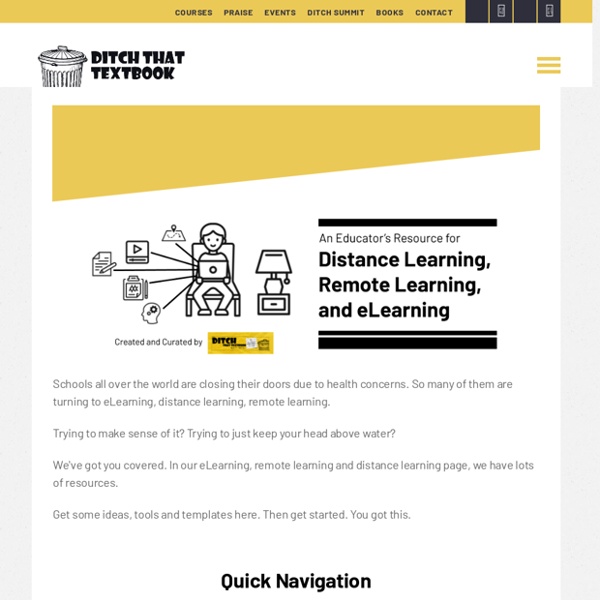IDEA - Illinois Digital Educators Alliance - IDEAs for @Home Learning
With school closures, teachers can keep their lessons going remotely: Jennie Magiera, GoogleGlobal Head of Education Impact, founder@OurVoiceAll, and bestselling author of #CourageousEdventures pulled together some strategies for shifting to a remote learning environment. In addition, consider registering for this 2 part webinar series: Making the transition to remote learning: To help make the transition to distance learning, Microsoft has created resources, training and how-to guides that we hope will help support IT, educators, staff and students as they make this transition. E-Learning Alternatives: Strategies that keep the focus on the learning target during remote learning experiences.
How to Teach Remotely
One of the central challenges posed by remote learning is how teachers can know what students are thinking, and thus move their learning forward, when not interacting with them face-to-face. The concept of making thinking visible comes from Ron Ritchhart, Mark Church, and Karen Morrison’s eponymous book, in which they outline specific strategies for how to deepen student understanding through designing activities that elicit what students know. Visibility platforms overlap with many personalized learning platforms, in particular Pear Deck and Nearpod. In addition, using Seesaw students can annotate their work and show steps to a problem, with Padlet, an online bulletin board, students can post their work and give each other feedback in real time. Similarly, using Google Jamboard, a free interactive whiteboard, teachers can teach live interactive lessons, as well as set up interactive notebooks for students, an excellent option for math teachers, in particular.
Teaching, Tech and Twitter: eLearning Choice Boards: A step-by-step guide to creating resources you can use tomorrow!
With the VERY sudden need for eLearning resources teachers and parents can become easily overwhelmed. As a technology teacher on special assignment and a parent of a second-grader (who is now at home for the next month), I can definitely relate. I know we all want to create meaningful online lessons and activities for our students, however, just like in the classroom we need some ready to use materials to fill in the gaps as we create.
podcasts.google
Apr 25, 2021 Episode 35: Coaching Teachers in Modern Classrooms In this episode, we hear from Lisa Doty and Jamie Forshey, two educators who coach and support teachers in their school districts who are implementing the Modern Classroom instructional model. Show Notes Virtual Mentorship Program ( Screencast-o-Matic ( and Modern Classroom tutorial ( Modern Classroom resources ( Modern Classroom webinars ( School and District partnerships ( including Expert Consultation sessions Making Thinking Visible ( by Ron Ritchhart, Mark Church, Karin Morrison and Lisa’s infographics: * Chalk Talk ( * Connect-Extend-Challenge ( * Micro lab protocol ( * See, Think, Wonder ( * I used to think...
Talking to Children About COVID-19 (Coronavirus): A Parent Resource
A new type of coronavirus, abbreviated COVID-19, is causing an outbreak of respiratory (lung) disease. It was first detected in China and has now been detected internationally. While the immediate health risk in the United States is low, it is important to plan for any possible outbreaks if the risk level increases in the future.
30+ digital escape rooms (plus a step by step guide for creating your own) - Ditch That Textbook
Escape rooms are a fun adventure where you solve puzzles to escape from the room in a short amount of time. I love creating physical escape rooms in my classroom. They are fun and they get the students up and moving in the classroom. However, there are a few drawbacks to physical escape rooms. I have large classes, so usually I need two sets running at the same time.
The juice that makes Flipgrid even better (#DitchPod wrap-up)
Educators have incorporated Flipgrid video discussions into their classes all over the world. Flipgrid Fever is a real thing and students are responding. There’s a way to help students have more success with their Flipgrid videos, though.
Disaster Preparedness Tips for Families Affected by Autism - Autism Society
Disaster Preparedness Tips for Families Affected by Autism With the help of renowned emergency preparedness expert Dennis Debbaudt, who has a son with autism, former Autism Society Board Member Ruth Elaine Hane, and support from NASCAR driver, Jamie McMurray — the Autism Society is committed to helping families with special needs prepare for emergencies. During any emergency, a health crisis, natural disaster or man-made, it is necessary to be prepared with a plan and essentials.
Coronavirus Information for Higher Ed
Skip to main content Alert Top Message Due to concerns about COVID-19, the AAUP office has transitioned to telework. Please contact staff by email. Visit the AAUP Foundation Secondary menu
Educators' Well-Being During the COVID-19 Outbreak
Ten Strategies for Educators' Wellbeing: A Handbook for Schools During the COVID-19 Outbreak When a crisis or a disruption like the COVID-19 school campus closures occur, we all respond differently and our responses will change over time. These closures may remind us of past traumatic experiences like the outbreak of a war or civil unrest, or the sudden destruction of an earthquake or terrorist attack. Some of us had an opportunity to pack up and say goodbye to colleagues, students, and friends; some of us did not have that opportunity. Some of us are stuck in our apartments, spending most of our days alone. Some are far away from the community in which we were living, balancing parenting and teaching in a new environment.



